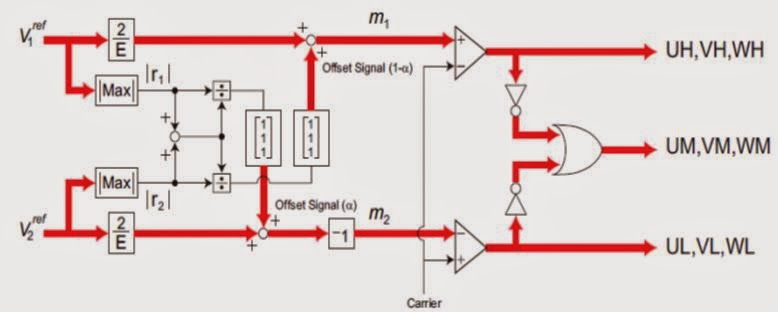Analysis And Design Considerations Of Zero-Voltage And
Zero-Current-Switching (ZVZCS) Full-Bridge PWM Converters
ABSTRACT
In this paper, a detailed
analysis of the zero voltage and zero-current-switching (ZVZCS) full-bridge PWM
converters is performed. The differences of the zero-voltage-switching (ZVS)
operation between the conventional ZVS full-bridge PWM converters and the ZVZCS
full-bridge PWM converters are analyzed in depth. Circuit parameters that
affect the soft-switching conditions are examined and the critical parameters
are identified. Based on the analysis, practical design considerations are
presented. The analysis and design considerations are verified by experimental results
from a 630V/4kW converter operating at 80kHz.
SOFTWARE: MATLAB/SIMULINK
CIRCUIT DIAGRAM:
Fig. 1 Circuit diagram of
ZVZCS FB PWM converter
Fig.2 schematic of the converter
CONCLUSION:
In
this paper, the zero-voltage and zero-current-switching (ZVZCS) Full-bridge PWM
converter was analyzed in depth. The difference of the zero-voltage-switching
(ZVS) principle between the conventional ZVS full-bridge PWM converters and the
ZVZCS full-bridge PWM converters was analyzed in detail. Circuit parameters
affecting the soft switching conditions were examined and the critical parameters
were identified. Based on the analysis, practical design considerations were
presented. The design procedures can be applied to the various kinds of ZVZCS full-bridge
PWM converters [1-5]. The analysis and design considerations were verified by
experimental results from a 630V/4kW converter operating at 80kHz.
REFERENCES:
[1]
E. S. Kim, K. Y. Cho, et. Al., "An improved ZVZCS PWM FB DC/DC converter
using energy recovery snubber," IEEE APEC Rec., 1997, pp.1014-1019.
[2]
Jung G. Cho, Ju W. Baek, D.W. Yoo, Hong S. Lee, and Geun H. Rim, "Novel
Zero-Voltage and Zero-Current- Switching(ZVZCS) Full Bridge PWM Converter Using
Transformer Auxiliary Winding", IEEE PESC Rec., 1997, pp. 227-232.
[3]
Jung G. Cho, J. W. Baek, D.W. Yoo, H. S. Lee, and G. H. Rim, "Novel
Zero-Voltage and Zero-Current- Switching(ZVZCS) Full Bridge PWM Converter Using
a simple auxiliary circuit", IEEE APEC Rec., 1998, pp.834-839.
[4]
E. S. Kim, K.Y. Joe and S. G. Park, "An Improved ZVZCS PWM FB DC/DC
Converter Using the Modified Energy Recovery Snubber", IEEE APEC Rec., 2000,
pp.119-124.
[5]
H. S. Choi, J. W. Kim and B.H. Cho, “Novel-Zero- Voltage and
Zero-Current-Switching(ZVZCS) Full- Bridge PWM Converter Using Coupled Output Inductor”,
APEC 2001. pp.967-973










